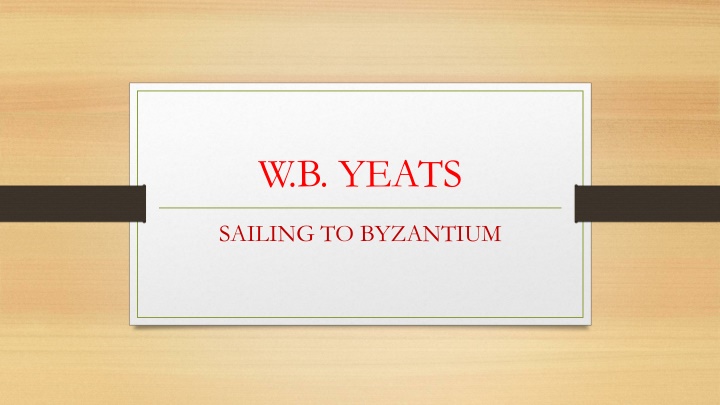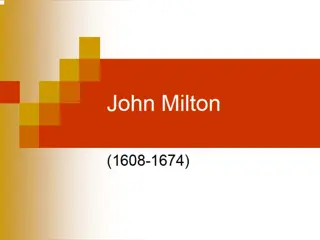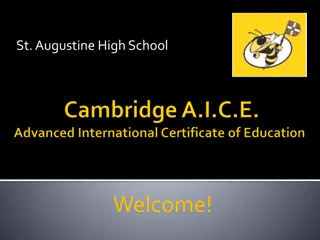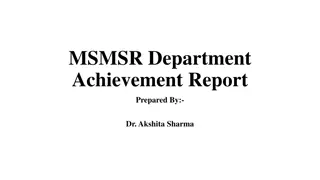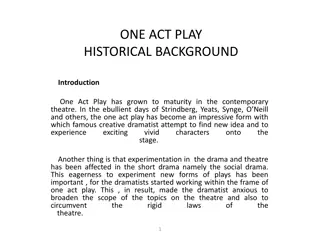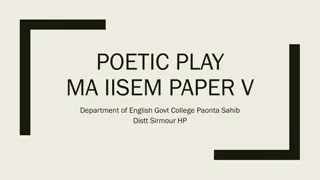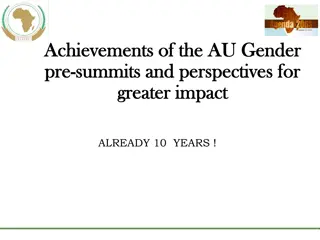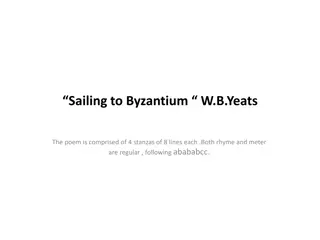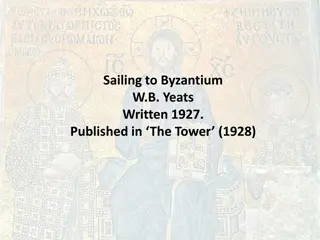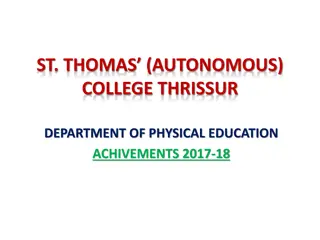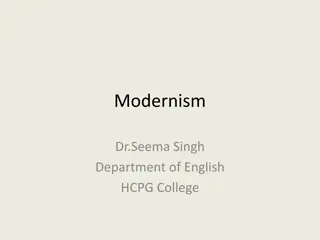Life and Achievements of W.B. Yeats
W.B. Yeats, the renowned Irish poet and writer, made significant contributions to English-language poetry in the 20th century. His life was marked by his interest in pagan beliefs, meeting Maud Gonne, and involvement in the Irish Literary Revival. Yeats' achievements include a blend of Irish folklore, Celtic influences, and a deep exploration of mysticism and the occult. His major themes revolved around the relationship between art and politics, Irish myth and folklore, and the transition from Romanticism to Modernism.
Download Presentation

Please find below an Image/Link to download the presentation.
The content on the website is provided AS IS for your information and personal use only. It may not be sold, licensed, or shared on other websites without obtaining consent from the author.If you encounter any issues during the download, it is possible that the publisher has removed the file from their server.
You are allowed to download the files provided on this website for personal or commercial use, subject to the condition that they are used lawfully. All files are the property of their respective owners.
The content on the website is provided AS IS for your information and personal use only. It may not be sold, licensed, or shared on other websites without obtaining consent from the author.
E N D
Presentation Transcript
W.B. YEATS SAILING TO BYZANTIUM
1. LIFE 1. (born June 13, 1865, Dublin, Ire. died Jan. 28, 1939. Irish poet, dramatist, and prose writer, one of the greatest English-language poets of the 20th century. He received the Nobel Prize for Literature in 1923. 2. Anglo-Irish protestant; separated from Catholics, and Protestants? 3. more interested in the pagan than Christian.
Life continued: 4. impact of Sligo. 5. He joined the Theosophical Society. 6. In 1889 Yeats met Maud Gonne, the troubling of my life began.
7. Death of Irish leader Charles Stewart Parnel, no political significance, turned to literature, art, poetry, drama. 8. Irish literary theater---Abbey theater.
9. Irish Literary Revival. 10. Madame Blavatsky and the Society of the Golden Dawn. 11. Miss George Hyde-Lees.
2. Achievements: 1. His early verse is in dreamlike atmosphere and the use of Irish folklore and legend. 2. Celtic and esoteric influences. 3. A tightening and hardening of his verse line, a more sparse and resonant imagery, and a new directness with which Yeats confronts reality and its imperfections.
4. A renewal of inspiration and a perfection of technique. 5. The Easter Rising and the Irish civil war; Yeats s own tower; the Byzantine Empire and its mosaics. 6. Meditation upon the relation between imagination, history, and the occult. 7. Japanese Noh plays.
Major Themes & Symbols Themes: 1. The Relationship Between Art and Politics. 2. The Impact of Fate and the Divine on History. 3. The Transition from Romanticism to Modernism. 4. Mysticism and the Occult. 5. Irish Myth and Folklore.
Symbols: 1. The Gyre. 2. The Swan. 3. The Great Beast.
Sailing to Byzantium Stanza 1: That is no country for old men. The young In one another's arms, birds in the trees Those dying generations at their song, The salmon-falls, the mackerel-crowded seas,
Stanza 1: Fish, flesh, or fowl, commend all summer long Whatever is begotten, born, and dies. Caught in that sensual music all neglect Monuments of unageing intellect.
Stanza 2: An aged man is but a paltry thing, A tattered coat upon a stick, unless Soul clap its hands and sing, and louder sing For every tatter in its mortal dress,
Stanza 2: Nor is there singing school but studying Monuments of its own magnificence; And therefore I have sailed the seas and come To the holy city of Byzantium.
Stanza 3: O sages standing in God's holy fire As in the gold mosaic of a wall, Come from the holy fire, perne in a gyre, And be the singing-masters of my soul.
Stanza 3: Consume my heart away; sick with desire And fastened to a dying animal It knows not what it is; and gather me Into the artifice of eternity.
Stanza 4: Once out of nature I shall never take My bodily form from any natural thing, But such a form as Grecian goldsmiths make Of hammered gold and gold enamelling
Stanza 4: To keep a drowsy Emperor awake; Or set upon a golden bough to sing To lords and ladies of Byzantium Of what is past, or passing, or to come.
Synopsis Stanza 1: The speaker introduces readers to a world that has no room in it for the elderly. It is a world in which young lovers embrace under trees full of singing birds (who seem unaware of their own mortality), the waters swarm with fish, and every living thing whether human, fish, or bird is born and then dies. Everything in that country is so caught up in the moment that it can pay no attention to the things that might outlive the flesh.
Stanza 2: An old man in this world is nothing but a skinny, ratty old scarecrow, unless he can keep his soul alive, vital, and singing within his failing, worn out body. No one can teach the soul to do this: the person who wants to keep their soul alive has to figure it out through their own study. For this reason, the speaker has taken a voyage across the ocean to the ancient holy city of Byzantium.
Stanza 3: The speaker addresses Byzantium's long-dead wise men and saints, who are now caught up in the glorious fire of God, which is like the beautiful golden tiling that decorates Byzantine churches. He asks them to emerge from this fire, whirling in spirals like the bobbin of a spinning-wheel, and to teach his soul to sing. He wants them to burn up his mortal, fleshly heart, which is tethered to his failing body and can't fathom or accept its own mortality, and to take him up into their everlasting world of art.
Stanza 4: When he's left his body behind, the speaker says, he won't take up a mortal physical form again. Instead, he'll be a beautiful piece of golden art, something that metal workers in ancient Greece might have made to hang in an emperor's bedroom. Or he'll be a golden bird placed in a golden tree, where he, like the sages, can teach people his eternal and otherworldly wisdom his transcendent understanding of the past, present, and future.
Themes 1. OLD AGE AND MORTALITY. 2. THE POWER OF ART.
Symbols 1. Gold 2. Art 3. Birds and Birdsong 4. Byzantium
Poetic Devices 1. Alliteration 2. Apostrophe 3. Assonance 4. Caesura 5. Diacope 6. Enjambment 7. Paradox 8. Parataxis 9. Sibilance
